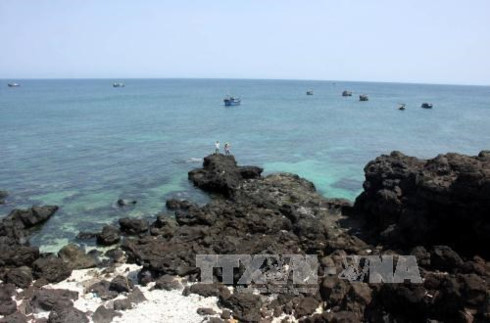
Destructive human activities have put coral reefs, sea grass beds and many other marine species off Ly Son Island at risk in recent years, with local authorities urged to make more efforts to preserve the unique ecosystem.

Ly Son Marine Reserve
in central Quang Ngai province, covering Ly Son Island and its surrounding
areas, has a water surface of more than
7,100 hectares,
including the 620-hectare no-take zone, an area of more than
2,000 hectares for
ecology restoration and another for development stretching across
4,470 hectares.
The sea protected area is known for high biodiversity and an ecosystem that
houses many rare marine species like black coral, maxima clams and abalone. But
these creatures are in danger of extinction due to the activities of local
people.
Fishermen have used explosives to kill many fish, seriously
harming coral reefs. Meanwhile, hundreds of locals harvest natural brown
seaweed, which offers shelter for many sea creatures, every May and June. They
can harvest an average of 3-5 tonnes of brown seaweed daily, making it
difficult to recover.
In addition, more than 150,000 sq.m of sand from beaches is exploited each year
to cultivate garlic, causing coastal erosion and depleting sea grass beds.
To solve the problems, the provincial People’s Committee adopted a project to
use advanced technology to restore coral reefs near Ly Son Island in 2015.
Experts have been sent to survey the coral reefs and raise local awareness of
the importance of animal and environmental protection. Local authorities and
residents have also been provided with training on how to recover coral reefs.
A model for coral recovery piloted across
2 hectares of the marine
reserve has developed well, giving hope of bringing back endangered species and
increasing local seafood yields.
The province urged Ly Son Island to intensify management of the sea protected
area by requesting tour operators strictly comply with the reserve’s
regulations and keeping close watch on the density and development of rare sea
species.
The island was also urged to get local people involved in protecting natural
resources and to guide them to fish sustainably.
Source: VOV
The emulation movement "Hoa Binh joining hands to build new-style rural areas” has been widely spreading, becoming a driving force that motivates the localities to renew rural landscapes and improve the material and spiritual lives of the residents. In this movement, the people play a central role-both as the main implementers and direct beneficiaries of its outcomes.
In response to the global digital revolution, Hoa Binh Newspaper is transforming itself into a modern and multi-platform media hub, blending cutting-edge technology with a restructured newsroom and a new generation of tech-savvy journalists.
Hoa Binh province’s Association of the Elderly recently held a conference to review the project on expanding the inter-generation self-help club model until 2025.
In a move to implement Resolution No. 57-NQ/TW, issued on December 22, 2024 by the Politburo, which targets breakthroughs in science-technology development, innovation, and digital transformation, the Hoa Binh provincial Department of Health has issued a plan to roll out the "Digital Literacy for All” campaign within the local health sector.
An Nghia Commune (Lạc Sơn District) is one of the communes that achieved the tha standard of the national new rural area in 2018. Entering a new development phase, the commune is now trying to meet the criteria for the advanced new rural development. With the strong political will and the public consensus, the commune is gradually overcoming the challenges to reach this goal, aiming for the sustainable development.



